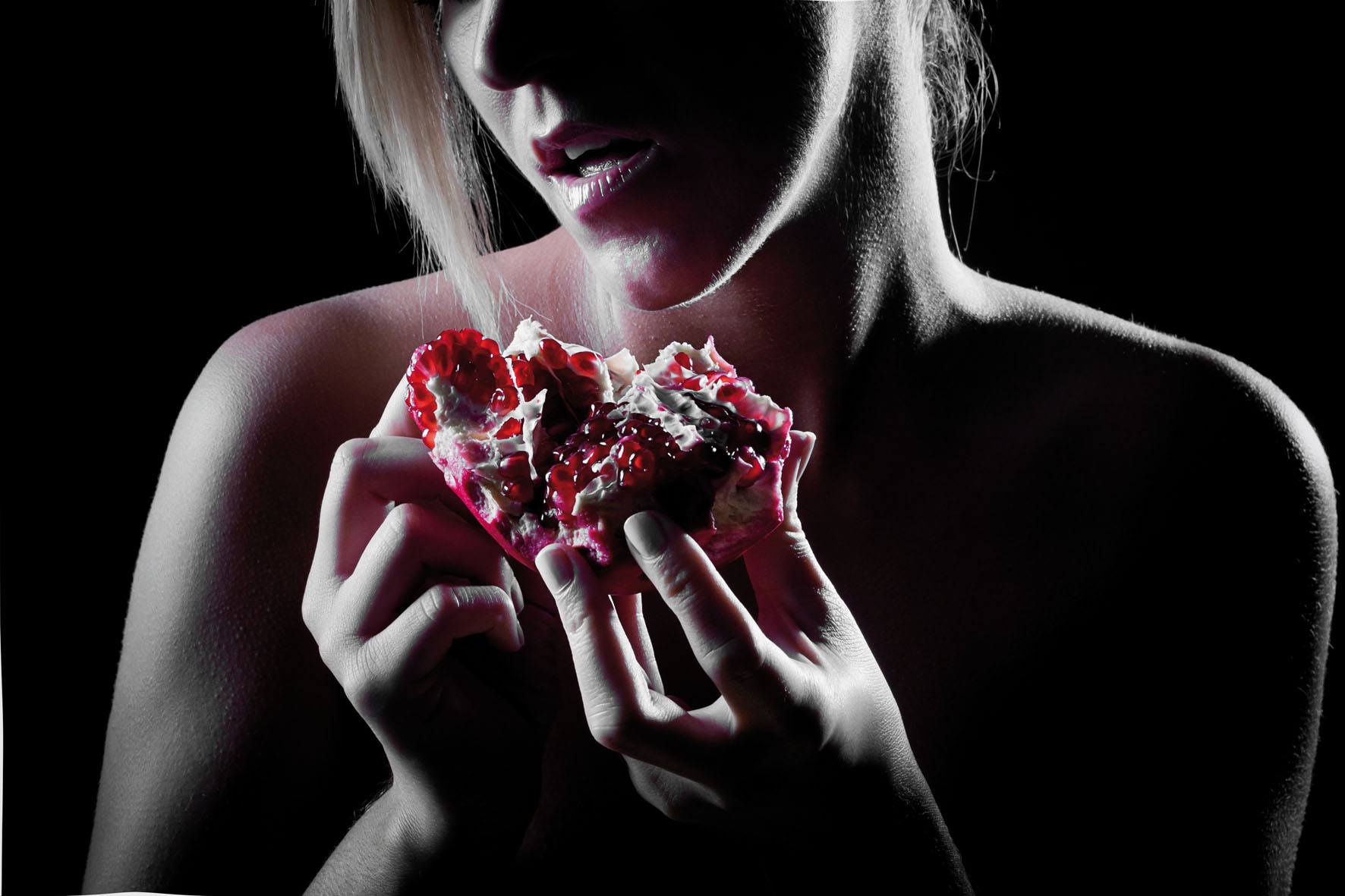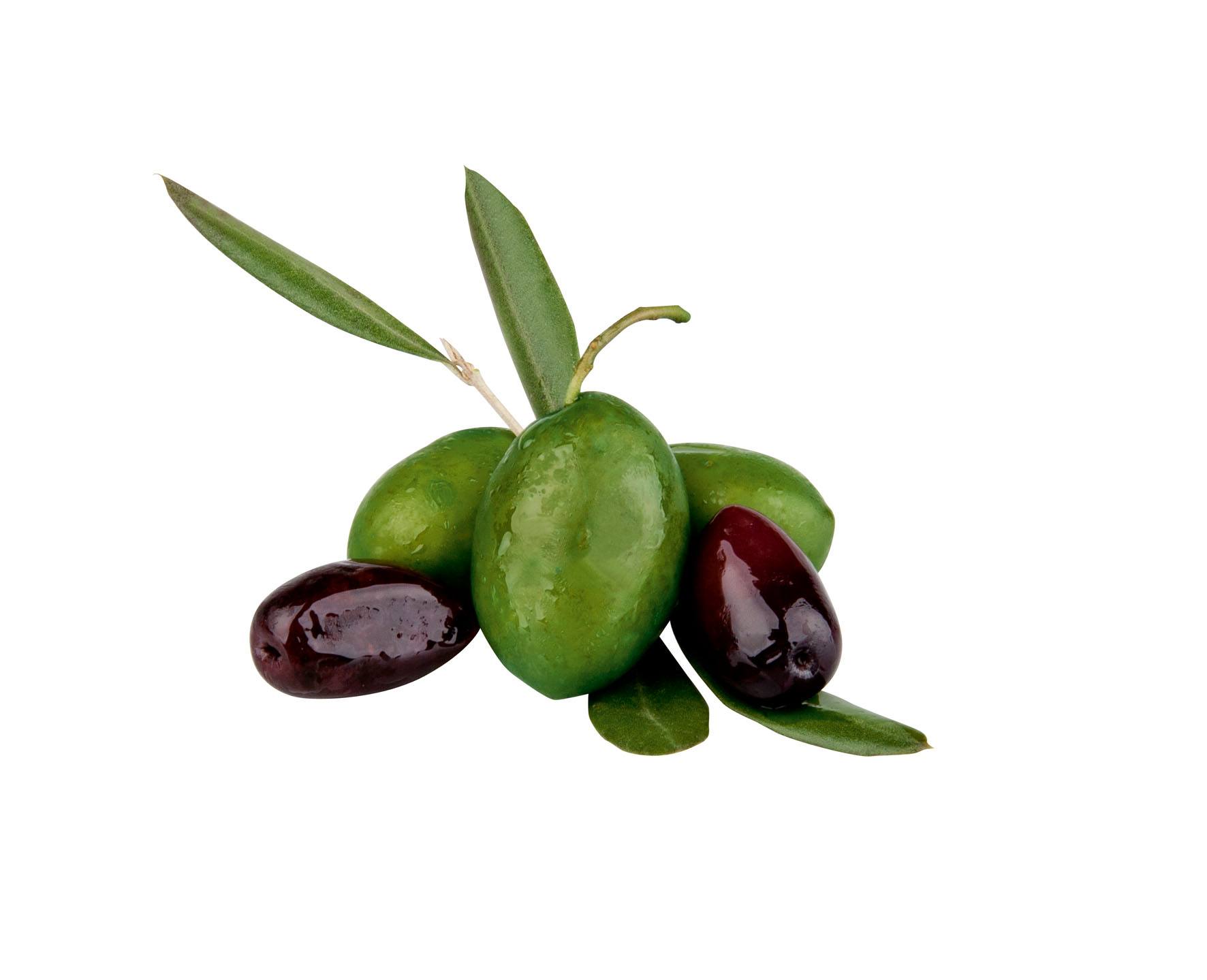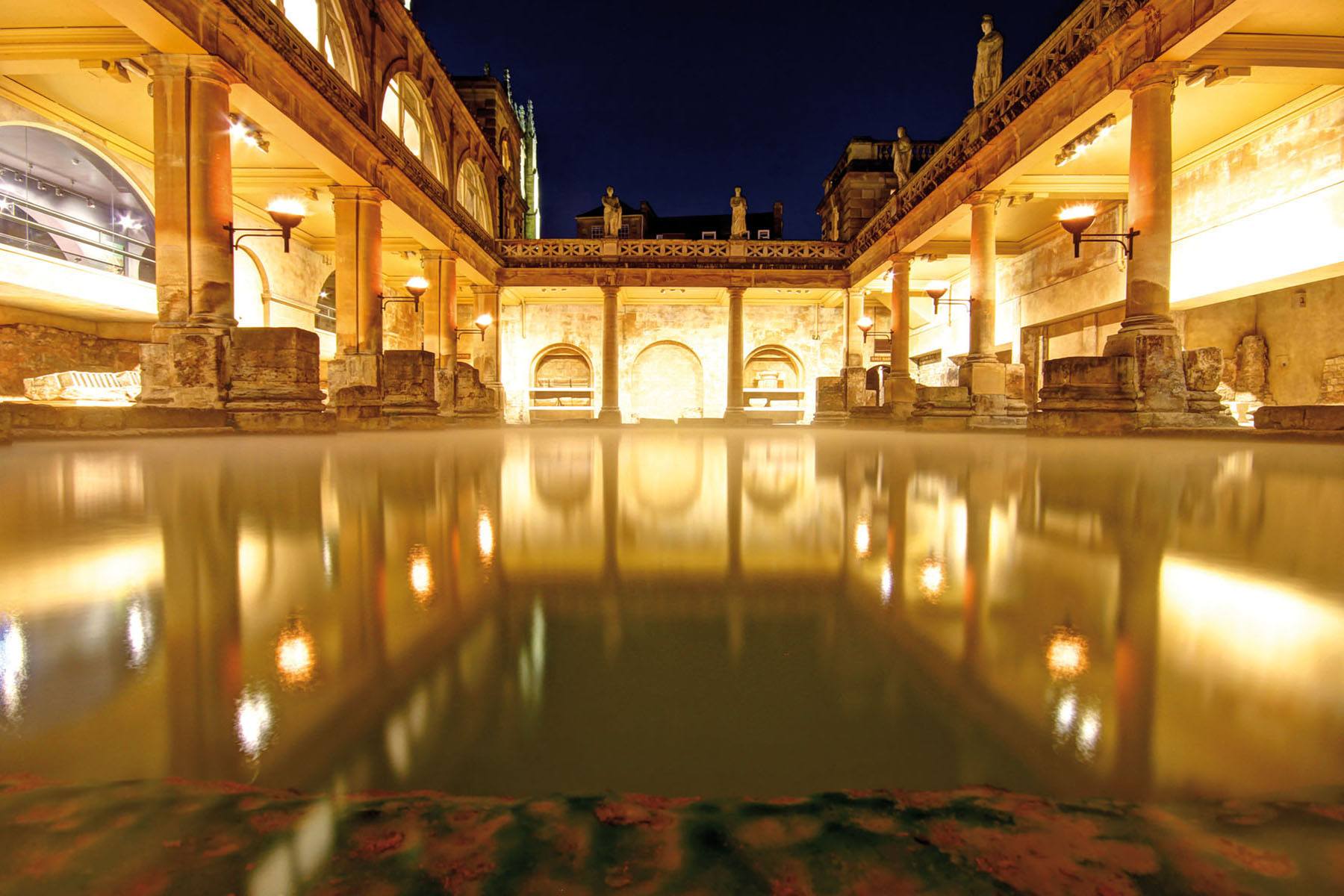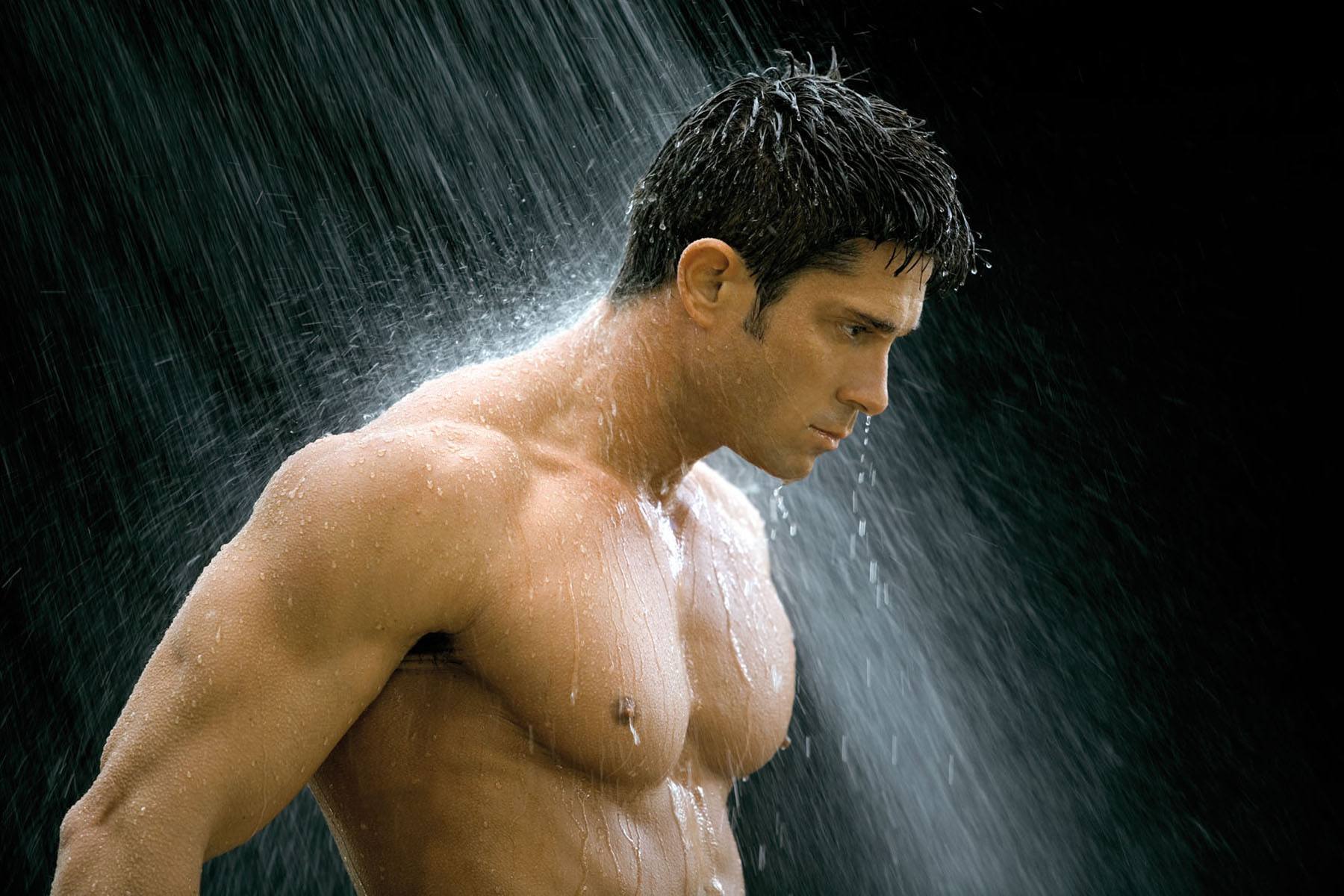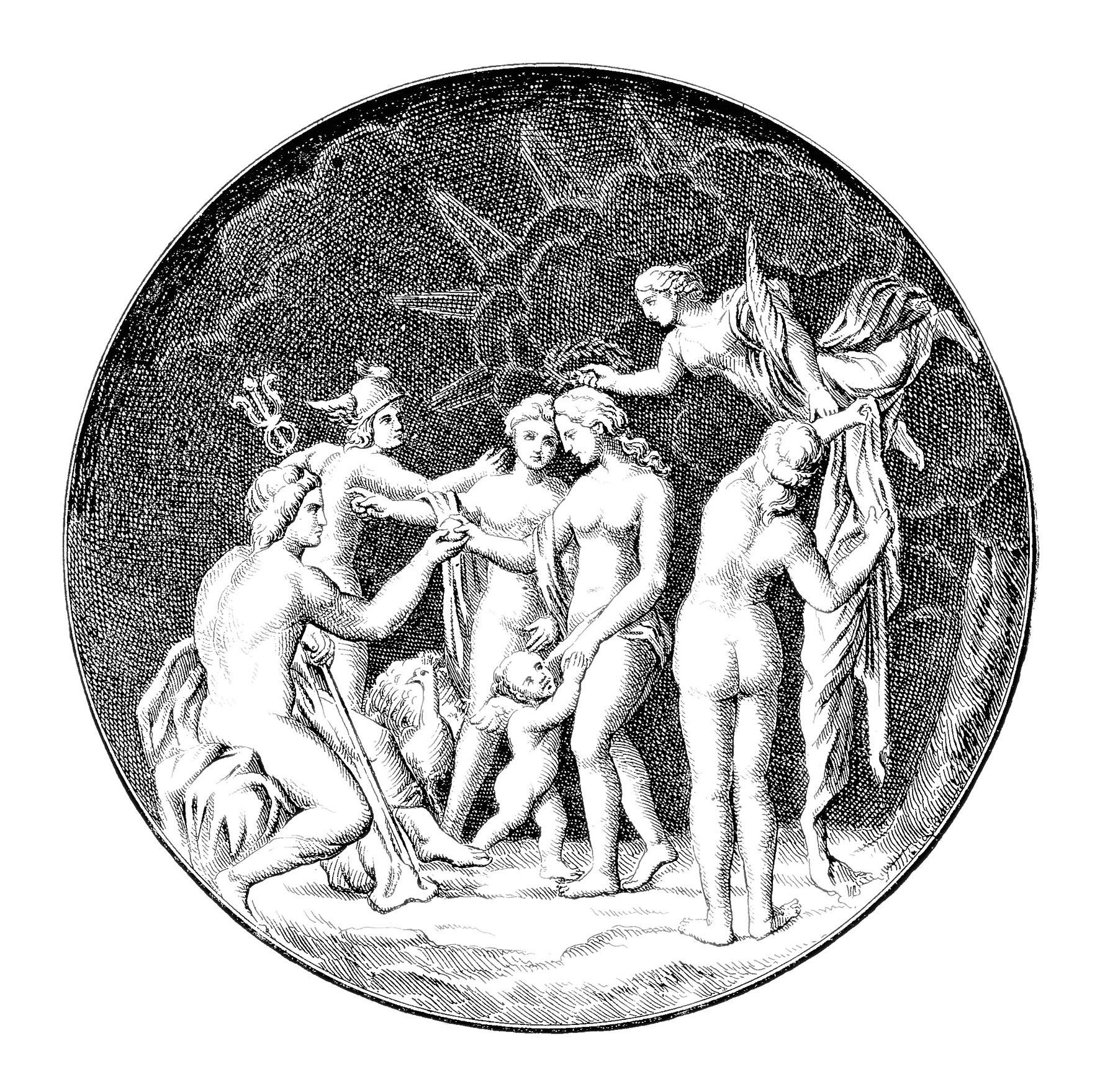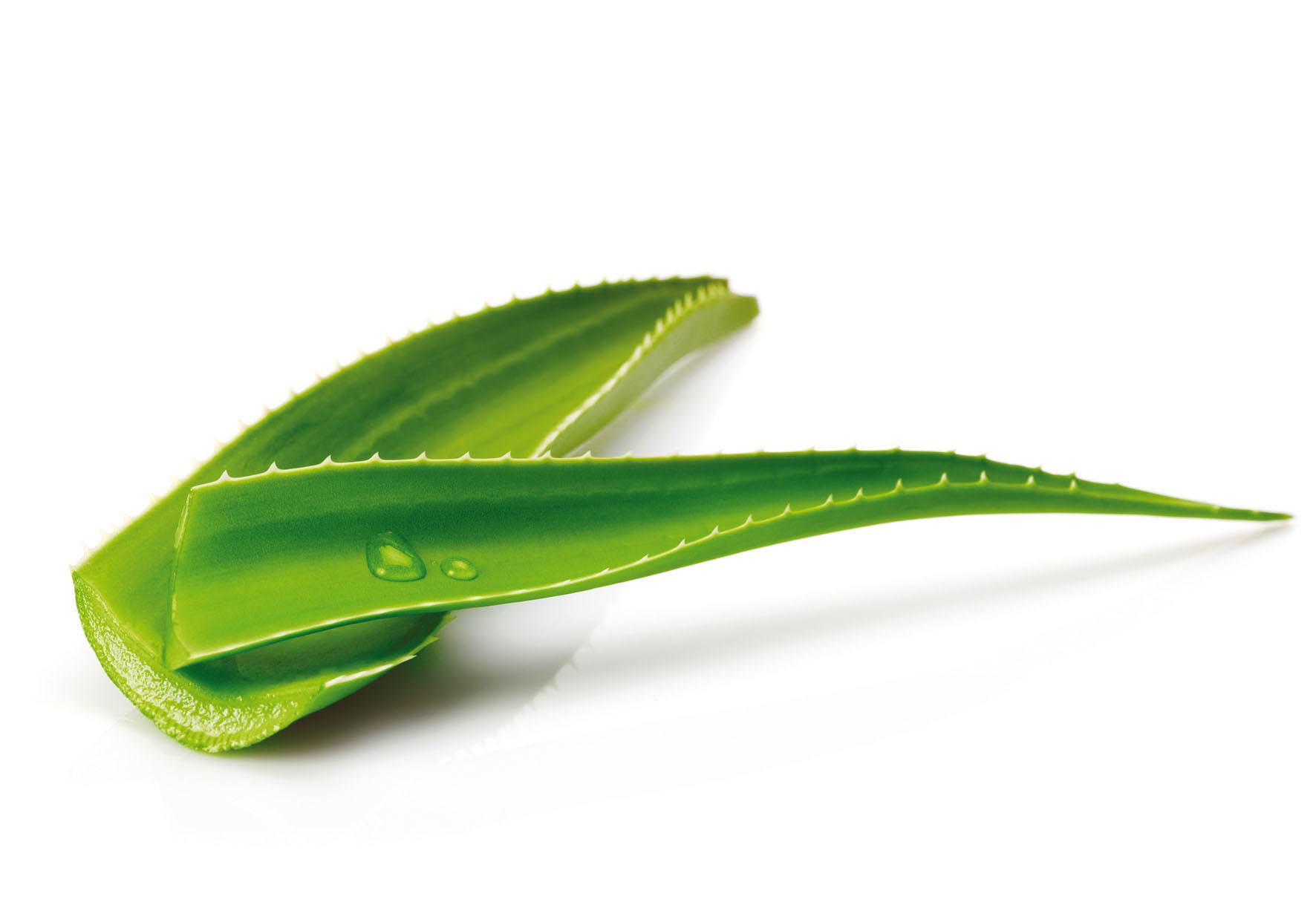Once upon a time, the Greek goddesses Athena, Aphrodite and Hera quarrelled about who was the most beautiful among them. The Trojan Paris ended their argument with a simple gesture. He handed Aphrodite a ripe pomegranate – the fruit of her favorite tree – and thus chose her as the most beautiful goddess. Since then, the pomegranate has been a symbol representing beauty, fertility and sensuality. It is, however, not by chance that the pomegranate was specifically given this symbolically important role in Greek mythology.
The pomegranate continuously surfaces as a symbol across the entire history of mankind. The pomegranate was even eternalized in the Bible. Its fruit is purported to have been plucked from the “tree of knowledge” by Eve. The pomegranate also served in a Greek and Roman ritual as a symbol for marriage: Young brides were made to carry blooming pomegranate branches. The German word for garnet (Granat), scarlet semi-precious stones that are reminiscent of pomegranate seeds in shape and color, refers to the fruit. The same applies to the ever so deadly grenades (Granate in German). The reason for this choice of name is that the pomegranate not only symbolised life and fertility, but also power – just think of an imperial orb – and, due to its color, blood and death as well. The Spanish town of Grenada is also linked to the pomegranate: At one time, the Moorish kings bore heraldic devices with the inscription “sour but sweet.” This was used to express the idea that good emperors, similar to pomegranates, combine sternness and kindness. In Chinese medicine, on the other hand, the pomegranate is seen as an aphrodisiac.
Potent guardians of health
Pomegranates contain powerful antioxidants – for example, the concentration of antioxidants in pomegranate juice is three times stronger than in red wine or tea. Antioxidants are versatile and potent guardians of human health. Among other things, they are used for heart conditions, high blood pressure and cancer prevention. Furthermore, they protect blood vessels and the immune system. In cosmetics, they are renowned for their unique ability to protect cells: for the reduction of wrinkles and as a prophylaxis against skin aging. Along with the antioxidative plant compound polyphenole, the pomegranate also offers additional protective ingredients. The red, succulent arils contain estrogenically active steroids and feature the highest ratio of gamma-linolenic acid in the entire plant kingdom. This triple unsaturated omega-6 fatty acid strengthens the acid mantle of the skin and improves skin elasticity. Furthermore, the plant compounds contained in the fruit help to prevent skin irritations such as inflammation of the skin, dry skin and itching. At the same time, the fruit extract refines pores and thus supports a more harmonious skin texture.
The pomegranate extract bundles this highly sought after range of compounds. Produced by means of high pressure extraction with naturally carbonated spring water, this process leaves no residues, meaning that the strict criteria of natural cosmetics are all met.
This success story has a long history: The olive tree was already venerated as a holy tree in antiquity, its cultivation can be traced back to 2000 B.C. and archaeological finds bear witness to the production, utilization and commercial exploitation of olive oil by the Egyptians, Babylonians, Minoans, Greeks and also the Romans. Unchanged throughout the ages, the high quality of the oil depends equally on the selected olive variety and ist degree of ripeness. The entire stone fruit is processed to produce the oil. The production chain – the harvesting, transport and oil extraction method – is the second significant factor for the production of high-quality extra virgin olive oil. Last but not least, the storage method and duration play a role as well.
Compared to other vegetable oils, extra virgin olive oil features a balanced composition of fatty acids, highgrade mineral substances and trace elements as well as vitamin A and large quantities of vitamin E. Olive oil’s vitamin E prevents the oxidation of numerous substances during their transport in the blood and thus protects the red blood cells. Furthermore, it stabilizes the cell membrane and in this manner even facilitates an astounding anti-aging effect. The jack of all trades olive oil also has a positive effect on the digestive tract, regulates acid production in the stomach and is recommended for the treatment of gastric ulcers.
Classification of olive oils
When talking about the exceptional properties of olive oils, people always refer to oils bearing the designation “extra virgin olive oil.” This is due to the fact that this term only applies to oils that are extracted from high-quality olives. Furthermore, the extraction method may not impair quality. The highest-grade extra virgin olive oils are yielded through cold pressing without the addition of water.
All other olive oil types exhibit quality defects – be it the use of damaged fruits or the consequences of inadequate manufacturing criteria that allow for deficiencies. According to the quality levels defined by the European Union, such lesser oils are classified as “virgin olive oil,” “olive oil,” and in the last step, “olive residual oil.” Residual oil represents the lowest quality level and is produced from extraction residues using solvents such as hexane or benzene. It is only approved for consumption if it is mixed with “virgin olive oil.”
Olive leaf extract
Oleuropein – a powerful antioxidant – is one of the most important substances of the olive tree. It is an important part of the fruit and thus the olive oil. However, this bitter substance is found in large amounts in the olive leaf. Its concentration there is 300 times greater than in olive oil. This is due to the fact that the leaves remain on the tree for around five years, while the olives only spend a few months on the branches. In order to harness the valuable extract, the leaves are picked by hand prior to the olive harvest and immediately processed in their fresh state.
The range of effects of oleuropein is impressive: It has anti-bacterial, antiviral and antimycotic properties and is the reason for the great resilience of olive trees, which can reach an age of a thousand years. Olive leaf extract functions as an oxidation inhibitor which captures free radicals, bonds with them, and thus neutralizes their damaging effect on somatic cells. In cosmetics, olive leaf extract guards against premature, light-related skin aging and the skin is also protected against irritations.
The bath houses of ancient Rome, bursting at the seams with visitors, ushered in a decisive cultural development: Water was no longer just useful, but was also a source of pleasure. This type of public bathing culture, which also went hand in hand with overflowing sensuality, came to an abrupt end with the fall of the Roman empire and the rise of a new code of morals. Based on the Roman bath houses, the Muslims built their own bathing facilities – with the difference being that the splendid hammams were places of leisure and silent rejuvenation. The act of physical cleansing, accompanied by music and meditation, simultaneously celebrated physical seclusion and spiritual contemplation. One stayed here for hours – in some cases, days. Even today, hammams are still an important part of the societal structure of Islamic countries, and Europe has now also discovered these exotic bathing oases for itself.
Formation of the spas
The rapidly increasing flow of visitors to springs said to have healing powers advanced the creation of the first spas in Europe. However, guests could not expect a great number of amenities. Apart from the springs, only spartan accommodations and, in many cases, mediocre food were available. This, however, did not detract visitors. A large number hoped for miracle cures, but reality did have its good sides as well: Numerous springs eased skin diseases and people saw the therapeutic effects on both the body and the soul as something akin to a miracle.
“Water is H2O: Two parts hydrogen, one part oxygen. But there is also a third thing that makes it water. And nobody knows what that may be.” D.H.Lawrence
The age of Reformation replaced alchemy and magic with medicine and ushered in a profound change in values: hygiene for health. Doctors recommended drinking enormous quantities of high mineral content water, which was supposed to cure every single disease. Due to the fact that certain springs were said to hold a higher potential for healing than others, the client structure also underwent a change. The aristocracy and wealthy individuals represented a patient segment that wanted to maintain its luxurious lifestyle while staying at the spa. People demanded exquisite lodgings and elegant facilities – and the cornerstone for the creation of the grandiose spas was laid. The old Roman bath houses were revitalized and Europe caught spa fever. People bathed together, experienced invigoration and rejuvenation, revitalized the soul and strengthened the mind. Last but not least, the baths served as a place to take time off from the Victorian moral code, which was ever-present in daily life. As a result, people enjoyed unchecked eroticism and unburdened freedom in the circle of like-minded spa visitors. Beethoven and Goethe preferred the Karlsbad spa, Napoleon idled in Vichy and Turgenev relaxed at Baden-Baden.
New water trend – new myths
Due to the world wars of the 20th century, the bath houses lost their importance. It was not until the fitness boom of the 1980s that water returned to the public focus in the field where society has always had a major demand and will probably always have one: physical and mental health. Therefore, new myths have also entered into the world of water. Borne by the hope that we could wrest the last secrets from the omnipresent water. One of these new myths – which has not yet been confirmed, but has also not been disproved – is “vitalized water.” This term originates from the observations of the Tyrolean forester and independent natural scientist Viktor Schauberger, who, in the 1920s, came to the conclusion that unknown powers are at work in nature. These release energy in concentric whirls. Based on this observation, he developed the hyperbolic “Schauberger funnel” to improve the quality of drinking water. Instead of storing it in straight pipes, it would be returned to its original spiral curve state, thus energizing and improving the quality of the water. Another similar example is “Grander water,” which is produced using a water vitalization process that represents a healthy medium for useful micro-organisms. Although it has not been scientifically proven, the company’s now global clientele absolutely believes in the effectiveness of Grander water. The Japanese author Masaru Emoto has also entered the fray of the new water myths. His topic of choice is crystal photography, in which he attempts to find a connection between the shape of the crystals and the quality and condition of water. Emoto claims that water can be “animated” and improved by emotion – for example by treating it with music.
“When the well is dry, we understand the value of water.” Benjamin Franklin
One can choose to believe in these myths surrounding water and its properties or not. Nevertheless, animating water is a lovely idea. Especially because there is at least some truth to it. Animating water can also be understood as breathing new life into man. And this feat is one that water has accomplished time and time again over the course of history. Today we call it wellness. More than ever before, the balance between the mind and the body has gained importance in our rapidly moving age. And once again, water, as the universal element, is at the center. As an effective aid for beauty and health. As a comforting way to slow things down. As a way to reduce life to the things that matter – be it a contemplative soak in the tub at home, which helps the mind recover from the overwhelming amount of stimuli we are exposed to every day. A short trip with friends to a health resort where one not only takes care of oneself during the bathing ritual, but also cultivates social contacts. Or just a simple glass of fresh water, which has always revitalized us and lets us remember that not only is every drop precious, but also a part of ourselves.
The spoken word has power. But not nearly as much as one would like to believe. Quite frankly, the verbal level of communication is lost ground, as the non-verbal approach makes up around 97% of direct communication between people. In other words, it is not so much about what we say, but how we conveyit.
In the fray of multi-faceted gestures and facial expressions, how we look at somebody plays a special role. It is, so to speak, the alpha and omega of expression by means of body language – independent of age, gender and culture. A brief glance is sufficient to gain insights into the frame of mind of the other person. Sympathies and antipathies are determined within the first moment. And here they are again – the magic three seconds – covering all major communicative actions – be it shaking hands, a hug or, on the other hand, a threatening gesture. Those who look a stranger in the eye will soon realize that the three-second rhythm has also been ingrained into humanity in this regard. After this amount of time has passed, we tend to either blink or look away.
Sleep makes you attractive
The idea that the eyes are the window to the soul is therefore not just a romantic idealization, but part of our conscious and subconscious reality. And the colloquial term “to make eyes at somebody” is definitely justified. What is deemed beautiful depends on different factors.
A study published in the “British Medical Journal” in 2010 took a closer look at so-called beauty sleep and proved a direct correlation between sleep duration and attractiveness in the course of the experiment. The result: In a sleep-deprived state, test subjects were perceived as less attractive, less healthy and significantly more tired.
The correct care – sparkling eyes
Eye care therefore plays an important role when it comes to improving one’s own outward appearance. Men and women can have sparkling eyes at any age. With the right care, wrinkles can be significantly refined. They do not, however, reduce the feeling of attractiveness as long as the complexion is even, the eyes are rested and the expression signalizes attentiveness. Wellness for the eyes therefore also means – if necessary – not shying away from suitable optical aids.
Nobody has to wear contact lenses if they have problems with them. Beautiful eyes can be accentuated much better with well-adjusted glasses than if they are red and irritated. Chamomile tea bags have a soothing effect on reddish eyes and a few slices of cucumber provide the sensitive skin around the eyes with the required moisture. Those of us lacking the necessary time should rely on trusted cosmetic helpers. The use of high-quality natural cosmetics already shows visible effects after only a few applications; with the advantage that the natural ingredients simultaneously develop a long-term effect and counter a wrinkled, tired appearance: The skin is smoother, stronger and is supplied with all the vitamins it needs.
Today’s search for health and beauty is often akin to an odyssey. Unconsidered habits, daily time pressure and an oversupply of products have significantly diverted man away from his actual path – a lifestyle close to nature. One that can actually deliver all the things promised by the food and cosmetics industry. Everywhere you read, you hear about a resilient organism all the way to smooth, wrinkle-free skin. This sounds enticing. However, the body can only be vital and beautiful if healthy nutrition and long-term care go hand in hand.
Those who turn their gaze inwards immediately know which foods on their own menu are agreeable. When it comes to cosmetics, this is a bit more difficult. Products based on softeners and other additives often feign a hair and skin state that does not actually exist. For example, some standard creams clog pores and cover the skin like a film. On the outside, this gives the impression of softness, but the reality of the situation becomes clear the next time you shower. The skin suffers beneath the supposedly treated surface. Instead of disposing of such products, a lot of people react in the opposite manner. Hoping for regeneration, they use even more – a vicious cycle that can have serious consequences. The skin can no longer breathe and waste products are no longer sufficiently secreted.
The true appearance increasingly deteriorates: The skin becomes drier and more wrinkled. And this is despite the fact that the road to healthy care has actually been paved for a long time: Body care products made from natural ingredients support the metabolism of the skin and thus not only contribute to natural beauty, but also to health on a long-term basis.
What can I put into my body?
Damaging substances enter our bodies both through the skin and by means of the food we ingest. Deposited in the connective tissue, chemical additives from foodstuffs and care products put a strain on the body. It is therefore important to know what one should eat and how to care for oneself. Natural agents help the body to reach an equilibrium. And what is good for the body also affects the psyche. Therefore, scrutiny pays off by ensuring that the body only gets the things it can actually benefit from. This rules out a lot of convenience products the food and beverages industry has to offer. The general rule is that fresh things are good things.
A simple question serves as an orientation aid in the supermarket: Which products would exist without the food industry? The remaining products are in most cases healthy or at least justifiable. Based on the example of potato chips, this means that industrially produced chips cannot be recommended. Because these chips are often just potato powder that has been pressed into slices, loaded with flavor enhancers and then fried in cheap oil, they are not part of a balanced diet. If, on the other hand, one dries fresh potato slices in the oven, sprinkles them with high-quality vegetable oil and uses natural flavourings, then chips can definitely support a healthy diet.

In cosmetics, the same principle applies. When they remain unaltered, natural ingredients can realize the full potential of their powerful effects. Old household remedies in particular have proven their worth over Feuchtigkeitsvergenerations – as cosmetics and as a remedy for physical ailments. However, those wishing to do their body some good do not necessarily have to scour the woods for herbs. High-quality natural cosmetics products have harnessed the positive effects of natural ingredients and now significantly stand out from mass products. They guarantee the use of high-quality ingredients and compliance with strict manufacturing criteria, such as the lack of softeners. In order to make an individually balanced choice, one must know what the skin requires for optimal care as well as which properties the various plants have. Biological wheat germ oil and top-quality aloe vera, for example, highlight the tremendous power contained in natural substances.
Ancient Arabic features no less than 33 metaphors to describe hair on the head – from “darkness” and “net” to “night,” and right up to “raven.” A groomed, full head of hair has always been seen as both aesthetic and erotic in men and women. The remaining body hair, on the other hand, has always been seen as an annoying nuisance, to be dealt with by whatever means and techniques necessary. A hairless body signalled diligent care, while those who let hair grow on their body were viewed as sloppy and soiled. Even works as early as the “Ars amatoria,” written by the Roman poet Ovid, supplied instructions on how to correctly care for the female body – shaving was a “must.”
Over the course of time, women have especially refined their rituals on how to remove unwanted body hair – on the legs, in the armpits, but also in the pubic area. In the hammams, for example, an abundance of hair removal creams and salves were used, including “Halawa” – a mixture of lemon juice, water and sugar, which similar to removing hair by means of waxing, was ripped off the skin and removed the hair with its root. This method, which was known as “sugaring” and was handed down over centuries, still causes tears to spring in the eyes of men and women today. Just imagine people wincing in the ancient bath houses from the same pain as today in modern hair removal studios. And this act of torture always had the same goal: to be beautiful and desirable. But such endeavors are not for every type of skin.
Soft and smooth
Wet shaving is still the most skin-friendly method for hair removal. It does entail having to make use of the razor more often in order to obtain that silky skin feeling, but on the other hand, correct handling with a “solid tool” and high-quality shaving care products allows you to deal with far less redness, inflammation and ingrown hair than alternative methods such as waxing or plucking.
However, there are a few things that need to be kept in mind to achieve optimal results: Hair should not be longer than about a third of an inch as it will not stand up otherwise and will be difficult to shave off. Especially sensitive areas such as the armpits or the pubic area require taught skin in order to be shaved completely and safely. Furthermore, the blade should only be guided against the growth direction of hair in areas where the skin is not sensitive. The regular final touch should be achieved by means of peeling. It removes shed flakes of skin and avoids ingrown hairs.
If you follow these hints and tips, you will be astounded at how soon the skin returns to youthful suppleness. At this point, it is best to let someone else stroke it and one thing is bound to happen: the “wow – how smooth!“ effect, and maybe even a little bit more…
Looking at a drop of water, you are essentially looking at yourself. A human being is made up of roughly two thirds water. No human, no individual organism on this world could have ever developed without water. This knowledge has existed for a long time, even before we were able to put it down in writing. Water was already venerated in antiquity as the source of all existence.
The German philosopher Hegel dubbed it the element of the selfless opposite: “Water’s existence is being-for-others… its determination is to be the thing that is not yet special and it has therefore been called ‘the mother of all special things’ from an early age onwards.” Across civilizations, most of which assumed that life had started in the oceans, an abundance of creation myths have been developed. In their different versions, they all depicted water as the mirror of the universe and subsequently found their continuation in the world religions. The first book of Moses, for example, states: “In the beginning God created the heavens and the earth. Now the earth was formless and empty, darkness was over the surface of the deep, and the Spirit of God was hovering over the waters.”
In the Japanese creation myth, a gigantic carp awakens from its slumber and thrashes around so violently that it creates a tidal wave, causing the Japanese islands to surface on the face of the earth. The Indian god Vishnu, on the other hand, shapes the earth while resting on a snake gliding through the cosmic waters.
Ancient water myths
Starting in antiquity, several water gods were venerated. Some were benign, others evil. They were all, however, omnipotent. Like Okeanos, for example, the origin of all gods and simultaneously the river flowing around the world, or Poseidon, the god of the ocean. The most alluring of the classic goddesses relating to water is Aphrodite or Venus, her Roman counterpart. According to the myth, she was born of the semen of sea foam and blood and rose out of a scallop on Cyprus. She was so beautiful that the seasons of the year came and were bedazzled by the sight of her. As the goddess of love and beauty the “foam-born” inspired numerous artists. This led to the creation of some of the greatest masterpieces in art history, such as the Greek antique statue “Venus of Milo,” Botticelli’s painting “Birth of Venus” or Titian’s work of art “Venus of Urbino.”
People also believed in water nymphs who reigned over streams, springs and grottoes, in sea nymphs who saved mariners and shipwrecked sailors, but also in sea monsters and mermaids – seductive and irresistible creatures – who robbed men of their senses with their demonic attraction and at times cost them their lives. They embodied both the life-threatening and life-giving aspect of water. However, the veneration of water found its expression not only in mythology, but also in cultural rituals.
In order to produce rain, people carried out mystic ceremonies, in the course of which rain dances were performed to exhaustion. Sacrifices were made or processions held with songs of invocation. One washed away “evil” with holy water and subjected the spirit to a spiritual cleansing, also mirrored by the washing of the dead in all cultures. And last but not least, the ritual of baptism symbolizes a bond with God for believers.
The primary functions of the upper layer are the immune response as well as UV protection and protection against dehydration. The true skin, on the other hand, is responsible for the production of oil via the oil glands and thermoregulation. This is where the alarm system of the skin is located, nutrients are transported through blood vessels and waste products are secreted via sweat glands. The subcutaneous tissue also plays an important role in regulating temperature and transporting nutrients. Furthermore, pheromones are produced here, and the body’s own water is regulated by means of blood vessels and the lymphatic system. Last but not least, the subcutaneous tissue also has buffering and insulation functions.
The hydrolipid film
The surface of the skin is covered by a thin film, which consists of body oils from the oil glands, free lipids and sweat compounds: the so-called hydrolipid film. The fatty acids are partially broken down by lipases (fat-splitting enzymes); this results in a slight lowering of the pH-value to 5.5–6.5, i.e. to a slightly acidic state. This is where the term “acid mantle” comes from. This primarily has an antimicrobial protective function and supports the smoothness of the skin. When it comes to supplying moisture, the hydrolipid film does not play a starring role: This function is mostly taken over by the lipid layer.
Two factors are significant for the healthy appearance of our skin: On the one hand, an intact, smooth and flexible horny layer without visible dander and, on the other hand, the moisture level of the horny layer. Hydrophilics, i.e. water-attracting substances, capture water in the cells. The impulse for the skin to form these substances depends on their water level. They consist of amino acids, free carbonic acids, pyrrolidone carbonic acid, organic acids such as lactic acid, salts such as sodium, potassium and calcium, and urea.
Maintaining skin moisture levels
Natural cosmetics offer two effective strategies to keep moisture in the skin: The first aims at utilizing water- attracting substances, which bind moisture upon application and keep it in the horny layer. They are utilized by corresponding compounds in the aqueous phase; valuable phospholipids in vegetable oils feed them into the skin and support its hydration. The other approach makes use of the ability of vegetable oils to reconstruct the barrier layer of the skin and to reduce water evaporation of the skin, without completely clogging it. As a result, the flow of the body’s own water is inversed and skin moisture is maintained. Phytosterols and fatty acids such as oil, palmitic and palmitoleic acid regenerate the lipid layers necessary for an intact horny layer.
Last but not least, a third factor also has a hydrating effect: Emulsions, which we normally use cosmetically, contain bonded water and so-called bulk water depending on the emulsifier and the emulsion type. It is deposited in the hydrophilic areas of the lipid layer and can immediately saturate the horny layer in an effective manner. The bonded water of the emulsion, on the other hand, is distributed gradually, similar to a water reservoir. Furthermore, active agents of an emulsion are more easily absorbed by intact skin, as they are offered in a form which corresponds to the structure of the skin lipids.
Avocado oil and grape seed oil
In this regard, avocado and grape seed oil are able to work true miracles. Rich in lecithin, they are said to have a “gliding channel effect,” making them optimal pathways for active ingredients into the skin.
Wheat germ oil
The golden yellow wheat germ oil is also on the list of high-quality ingredients. It is among the most expensive vegetable oils and features a high degree of polyunsaturated fatty acids and vitamin E. As a result, it is effective against premature aging of the skin and also serves as an excellent hair protection agent. The polyunsaturated fatty acids support the build-up of cells in the hair root and can stop hair loss. Wheat germ oil also plays an important role in nutrition. It helps to lower cholesterol levels and increases physical performance.
Aloe vera
This nondescript member of the lily family features a unique abundance of active agents not found anywhere else in nature. The exceptional biological makeup of aloe vera includes polysaccharides, vitamins, enzymes, mineral supplements and amino acids – everything a healthy human organism requires. As a result, the “empress of the medicinal plants” plays an important role in natural cosmetics and serves to revitalize the body as a whole. As aloe vera has a cooling effect and provides a lot of moisture, it is counted among the best remedies for damaged skin, especially sunburns. Do note, however, that the concentration and quality of the plant additives must be correct. According to the World Health Organisation (WHO), the gel of the freshly cut leaf works best.
It would be easy to continue listing fantastic natural remedies, which exist in abundance and whose areas of application fill entire encyclopedias. On the following pages, however, we will explicitly deal with two great stars in the field of natural cosmetics – olive oil and the pomegranate.

